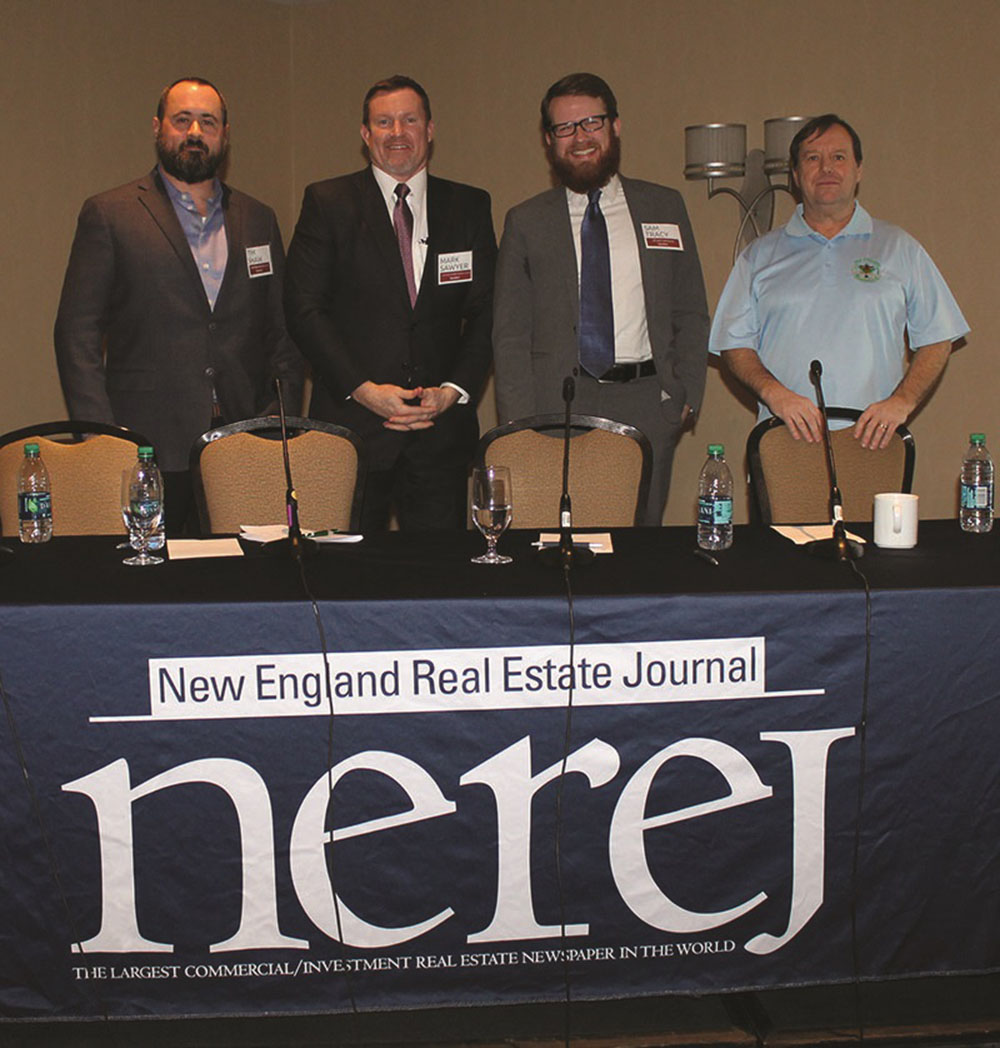Needham, MA Despite the cloud of uncertainty hanging over the cannabis industry brought on by recent political developments, those involved in the fledgling business remain optimistic about its future. Reflecting that optimism, over 130 professionals from the commercial real estate, law, insurance, construction, architecture, and finance arenas gathered at the Needham Sheraton on February 8th to share, learn, and discuss the next steps for the budding industry. The summit, “Cannabis…The Next Phase in Commercial Real Estate,” was hosted by the New England Real Estate Journal and consisted of two panel discussions accompanied by extended Q&A sessions with an enthusiastic crowd.
The panel discussions were preceded by a presentation by National Grid’s Kathleen Arthur, on how cultivators can maximize energy efficiencies in their facilities, which typically consume massive amounts of power. National Grid now partners with a firm with extensive experience in the cannabis industry to conduct energy audits of existing facilities, and also works with firms constructing new cultivation centers to implement cost-saving measures into the design process. “The programs in Mass., Rhode Island and New York State are all about doing the energy measures that make sense – not the measures that are so costly that they don’t pay back fairly quickly,” she emphasized.

John Henderson of iAnthus Capital Management; Bob Fireman of Marimed, Inc.;
and Jim Borghesani of Primepoint Strategic Media.
The first panel, moderated by Jim Borghesani, president of Primepoint Strategic Media and the former director of communications for the Campaign to Regulate Marijuana Like Alcohol, focused on the real estate aspects of the industry, for both cultivation facilities and dispensaries. Panelists included John Henderson, managing director at iAnthus Capital Management, which provides value-added capital, intellectual property, and comprehensive consulting services to state licensed cannabis cultivators and dispensaries; Scott Howe, senior VP at Solect Energy, which is providing turn-key solutions to lower costs and emissions for cultivation facilities; and Jon Levine, founder and CFO, and Bob Fireman, president and CEO of Marimed, Inc., a firm that provides consulting services for the design, development, operation, funding, and optimization of medical cannabis cultivation centers and dispensaries
At the outset of the first panel discussion, Fireman addressed the recent statements by the U.S. Attorney General Jeff Sessions and U.S. Attorney for Mass. Andrew Lelling regarding a potential federal crackdown on marijuana growers and distributors. “When people come to us for advice about getting into the cannabis business, we always tell them that this is a business that is fraught with challenges, at the state, federal and local level,” he said, adding that while the momentum towards attracting more institutional investors and making banks more comfortable with lending to the industry has slowed, Treasury secretary Steven Mnuchin has indicated that he is in favor of making banking more friendly to the cannabis industry. “And this is America. If you follow the capital, like the $300 million that Colorado is pulling in in tax revenue, the money and the people should prevail.”
The primary focus of the panel discussion, however, was more heavily geared towards the ways that cultivators and dispensaries could maximize their margins through wise real estate, energy and design solutions. Henderson of iAnthus Capital spoke first on the retail segment of the business, stressing that zoning and permitting issues, distance, (at least 500 feet from any area where children commonly gather), and location were the primary considerations for siting a dispensary in a municipality. And while the target space requirements for (medical use) dispensaries are typically in the 2,500-3,000 s/f range, requirements for growing facilities run from 15,000 to 100,000 s/f in most states. In Massachusetts, they tend to be smaller, he said, given that medical growers can currently only sell to their own dispensaries.
Although cultivation facilities use the same siting criteria as dispensaries, the location has less to do with foot traffic than access to employees, as cultivation centers usually employ between 50-150 people. Banks are still reticent to finance any aspect of the industry however – from preventing landlords from leasing space to cannabis concerns to lending money to those seeking to purchase property. And even those seeking to purchase buildings with their own cash face surprising challenges. “When you walk in and tell someone that you’re interested in buying the building for a cannabis cultivation facility, the price jumps from $15 per square foot to $25-$30,” conveyed Marimed’s Levine, who discussed the unique factors involved with operating a cultivation center. In addition to the high cost of leasing and owning real estate, Solect Energy’s Howe pointed out the growing centers “are huge energy hogs”, and that alternative energy solutions like LED lighting and solar panels are effective ways to curb energy costs.

of Corcoran & Havlin Insurance Group; Sam Tracy of 4Front Ventures;
and Mike Fitzgerald of the New England Grass Roots Institute.
The second panel focused on zoning and permitting concerns, facility design and operation, and insurance issues, and was moderated by Mike Fitzgerald of the New England Grass Roots Institute. Panelists included Tim Shaw, COO of Marimed; Mark Sawyer, senior vice president for the Corcoran & Havlin Insurance Group, which has a dedicated cannabis practice; and Sam Tracy, director of government relations for 4Front Ventures, a cannabis industry investment and management firm. Tracy began by noting that “towns and municipalities in the state are much more afraid of dispensaries than they are of cultivators,” so municipalities often make it difficult for dispensaries to open by endlessly extending moratoriums on marijuana sales, for instance. “But they’re much more welcoming to cultivators,” he observed, and cities such as Holyoke are now actually offering incentives to cultivators to locate there, because facilities are seen as job generators.
Sawyer heads the marijuana practice for his firm, which currently has over a dozen clients in the cannabis industry. Sawyer cautioned the crowd that many landlords do not carry cannabis specific coverage, which may leave them without protection. “Every insurance product associated with cannabis has to be specifically endorsed on the policy, and disclosed to the carrier” he stated. Marimed’s Shaw gave a comprehensive overview of the myriad of components involved in getting into the cannabis cultivation business, including security, power, environmental controls, design and construction issues, and emphasized the importance of working with architects and engineers who understand the requirements of a growing facility.
When asked what advice he would have for those seeking to get into the cannabis industry, given the uncertainty created by the political environment, Marimed’s Fireman offered this: “From a real estate standpoint, I say go forward,” he told the crowd. “We have to stand up, we have to make this industry work and to help other people in this space to bring cannabis out of the shadows to be regulated and safe.”
For information on other upcoming summits please contact Rick Kaplan at: rkaplan@nerej.com
